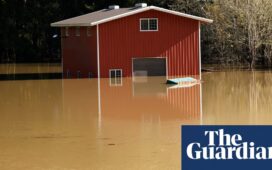It has been a record season for storms. On Monday night, Subtropical Storm Theta became the 29th named storm of the 2020 hurricane season, surpassing the total count from 2005.
Theta formed after Tropical Storm Eta spent the day battering Florida, causing heavy rains and flooding in state’s south and the Keys.
The tumultuous season has raised questions about how much climate change is affecting hurricanes in the Atlantic. Researchers can’t say for sure whether human-caused climate change will mean longer or more active hurricane seasons in the future, but there is broad agreement on one thing: Global warming is changing storms.
Scientists say, for example, that unusually warm Atlantic surface temperatures have helped to increase storm activity this season. The warmer ocean temperatures are “absolutely responsible for the hyperactive season,” said James P. Kossin, a climate scientist with the National Oceanic and Atmospheric Administration. “It’s very likely that human-caused climate change contributed to that anomalously warm ocean.”
It still isn’t clear whether that’s an exception or part of an upward trend, Dr. Kossin said. He noted that climate change might ultimately result in fewer storms.
Either way, he said, “climate change is making it more likely for hurricanes to behave in certain ways.”
Here are some of those ways.
1. Higher winds
There’s a solid scientific consensus that hurricanes are becoming more powerful.
Hurricanes are complex, but one of the key factors that determines how strong a given storm ultimately becomes is ocean surface temperature, because warmer water provides more of the energy that fuels storms.
“Potential intensity is going up,” said Kerry Emanuel, a professor of atmospheric science at the Massachusetts Institute of Technology. “We predicted it would go up 30 years ago, and the observations show it going up.”
Stronger winds mean downed power lines, damaged roofs and, when paired with rising sea levels, worse coastal flooding.
“Even if storms themselves weren’t changing, the storm surge is riding on an elevated sea level,” Dr. Emanuel said. He used New York City as an example, where sea levels have risen about a foot in the past century. “If Sandy’s storm surge had occurred in 1912 rather than 2012,” he said, “it probably wouldn’t have flooded Lower Manhattan.”
2. More rain
Warming also increases the amount of water vapor that the atmosphere can hold. In fact, every degree Celsius of warming allows the air to hold about 7 percent more water.
That means we can expect future storms to unleash higher amounts of rainfall.
3. Slower storms
Researchers do not yet know why storms are moving more slowly, but they are. Some say a slowdown in global atmospheric circulation, or global winds, could be partly to blame.
In a 2018 paper, Dr. Kossin found that hurricanes over the United States had slowed 17 percent since 1947. Combined with the increase in rain rates, storms are causing a 25 percent increase in local rainfall in the United States, he said.
Slower, wetter storms also worsen flooding. Dr. Kossin likened the problem to walking around your back yard while using a hose to spray water on the ground. If you walk fast, the water won’t have a chance to start pooling. But if you walk slowly, he said, “you’ll get a lot of rain below you.”
4. Wider-ranging storms
Because warmer water helps fuel hurricanes, climate change is enlarging the zone where hurricanes can form.
There’s a “migration of tropical cyclones out of the tropics and toward subtropics and middle latitudes,” Dr. Kossin said. That could mean more storms making landfall in higher latitudes, like in the United States or Japan.
5. More volatility
As the climate warms, researchers also say they expect storms to intensify more rapidly. Researchers are still unsure why it’s happening, but the trend appears to be clear.
In a 2017 paper based on climate and hurricane models, Dr. Emanuel found that storms that intensify rapidly — the ones that increase their wind speed by 70 miles per hour or more in the 24 hours before landfall — were rare in the period from 1976 through 2005. On average, he estimated, their likelihood in those years was equal to about once per century.
By the end of the 21st century, he found, those storms might form once every five or 10 years.
“It’s a forecaster’s nightmare,” Dr. Emanuel said. If a tropical storm or Category 1 hurricane develops into a Category 4 hurricane overnight, he said, “there’s no time to evacuate people.”


